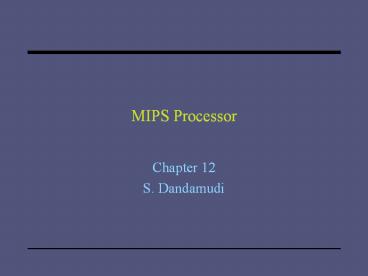MIPS Processor - PowerPoint PPT Presentation
Title:
MIPS Processor
Description:
Title: Interrupts & Input/output Author: S. Dandamudi Last modified by: Sivarama Dandamudi Created Date: 11/24/1998 12:49:00 AM Document presentation format – PowerPoint PPT presentation
Number of Views:97
Avg rating:3.0/5.0
Title: MIPS Processor
1
MIPS Processor
- Chapter 12
- S. Dandamudi
2
Outline
- Introduction
- Evolution of CISC Processors
- RISC Design Principles
- MIPS Architecture
3
Introduction
- CISC
- Complex instruction set
- Pentium is the most popular example
- RISC
- Simple instructions
- Reduced complexity
- Modern processors use this design philosophy
- PowerPC, MIPS, SPARC, Intel Itanium
- Borrow some features from CISC
- No precise definition
- We can identify some common characteristics
4
Evolution of CISC Processors
- Motivation to efficiently use expensive resources
- Processor
- Memory
- High density code
- Complex instructions
- Hardware complexity is handled by
microprogramming - Microprogramming is also helpful to
- Reduce the impact of memory access latency
- Offers flexibility
- Low-cost members of the same family
- Tailored to high-level language constructs
5
Evolution of CISC Designs (contd)
6
Evolution of CISC Designs (contd)
- Example
- Autoincrement addressing mode of VAX
- Performs the following actions
- (R2) (R2) R3 R2 R2 1
- RISC equivalent
- R4 (R2)
- R4 R4 R3
- (R2) R4
- R2 R2 1
7
Why RISC?
- Simple instructions
- Complex instructions are mostly ignored by
compilers - Due to semantic gap
- Few data types
- Complex data structures are used relatively
infrequently - Better to support a few simple data types
efficiently - Synthesize complex ones
- Simple addressing modes
- Complex addressing modes lead to variable length
instructions - Lead to inefficient instruction decoding and
scheduling
8
Why RISC? (contd)
- Large register set
- Efficient support for procedure calls and returns
- Patterson and Sequins study
- Procedure call/return 12-15 of HLL statements
- Constitute 31-33 of machine language
instructions - Generate nearly half (45) of memory references
- Small activation record
- Tanenbaums study
- Only 1.25 of the calls have more than 6
arguments - More than 93 have less than 6 local scalar
variables - Large register set can avoid memory references
9
RISC Design Principles
- Simple operations
- Simple instructions that can execute in one cycle
- Operations can be hardwired (see next figure)
- Register-to-register operations
- Only load and store operations access memory
- Rest of the operations on a register-to-register
basis - Simple addressing modes
- A few addressing modes (1 or 2)
- Large number of registers
- Needed to support register-to-register operations
- Minimize the procedure call and return overhead
10
RISC Design Principles (contd)
11
RISC Design Principles (contd)
- Fixed-length instructions
- Facilitates efficient instruction execution
- Simple instruction format
- Fixed boundaries for various fields
- opcode, source operands,
- Other features
- Tend to use Harvard architecture
- Pipelining is visible at the architecture level
12
MIPS Architecture
- Registers
- 32 general-purpose
- Identified as 0, 1, ,31
- Register 0 is hardwired to zero
- Used when zero operand is needed
- Register 31 is used as the link register
- Used to store the return address of a procedure
- A Program counter (PC)
- 2 special-purpose
- HI and LO registers
- Used in multiply and divide operations
13
MIPS Architecture (contd)
14
MIPS Architecture (contd)
- MIPS registers and their conventional usage
15
MIPS Architecture (contd)
- MIPS addressing modes
- Bare machine supports only a single addressing
mode - disp(Rx)
- Virtual machine provides several additional
addressing modes
16
Memory Usage
Placement of segments allows sharing of unused
memory by both data and stack segments
Last slide































